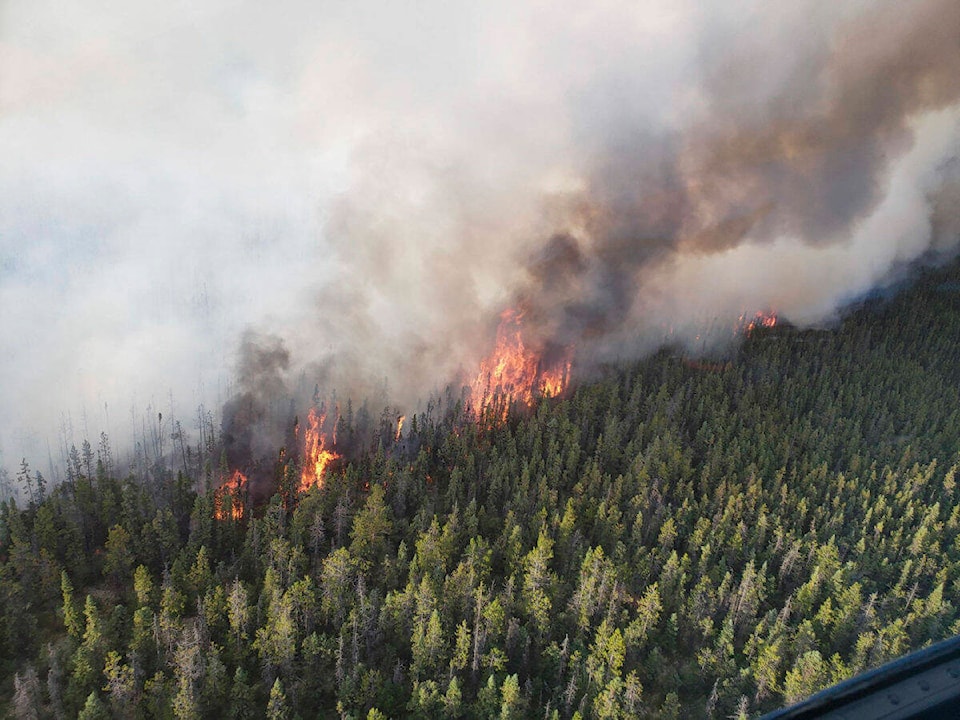A new deal marks an opportunity for reconciliation between Yukon First Nations and the territorial government when it comes to managing wildfires, the chair of Yukon First Nations Wildfire says.
“Today is a monumental day in the evolution of wildland firefighting in the Yukon,” Frederick Koe said during a joint news conference held over Zoom on Feb. 24.
The Yukon government wildland fire management branch and Yukon First Nations Wildfire announced the two parties have signed a three-year deal for unit crew services that will see funds provided by the territorial government used to employ 20 additional youth each year.
“These unit crews are trained to perform sustained action when a fire has grown beyond initial attack resources. This unit crew will add critical response capacity within the Yukon during periods of high fire danger and activity,” said Richard Mostyn, minister of Community Services.
Mostyn said the unit crew will also conduct forest fuel reduction and prevention and mitigation activities during periods of low fire activity.
It has been 20 years since the Government of Yukon’s wildland fire management branch took over management of wildfires from the federal government.
“Over those two decades we have refined a unique model of fire management that sees Yukon First Nations integrated into our initial attack program,” Mostyn said. “Today all 14 First Nations are involved in wildfire management in the territory. This partnership is unique in Canada.”
For the past two years, the branch has had agreements in place with Yukon First Nations Wildfire. Koe said his organization wants to become equal partners in “our quest to protect Yukon lands” and boundary areas.
“Yukon First Nations Wildfire is ready, willing and able to take on the unforeseen challenges sent forth by nature and it’s going to work cooperatively and in equal partnership with the Yukon government to take on these challenges,” Koe said.
On its website, Yukon First Nations Wildfire’s mission is to provide mentorship and job experiences to First Nation youth while training wildland firefighters, and 80 per cent of its 81 personnel were youth in 2020.
Lisa Walker, the director of the wildland fire management branch, said this program will involve approximately $400,000 of prevention and mitigation work each year, which comes from the existing wildland fire management budget. In addition, the branch is providing approximately $125,000 per year to fund capacity and training.
“It’s a very difficult thing to say whether or not we’re prepared and ready for something that we don’t know is coming,” Walker said. The branch is not yet monitoring the weather conditions that can predict fire risk for the upcoming fire season.
“Our wildland fire season begins in May, and that’s the time where we have our crews fully staffed and ready, trained and in place to respond,” Walker said. “At that time, we are monitoring, daily, the weather and the conditions that would allow us to redeploy resources in the areas that are likely to have fires occur.”
Koe said they have put the call out to fill positions on the unit crew from May to the middle of August. The Yukon First Nations Wildfire Facebook page has job postings for unit crew supervisor, unit crew squad boss and unit crew squad member, as well as other positions.
Koe said firefighters must get certified by passing a two-week intensive program that includes physical testing and equipment training.
“We’re going to plan for the worst and hope for the best,” Mostyn said.
“If we do run into problems, and we have a much more robust and much more intense fire season this year, then we have agreements in place across the country to be able to pull other resources into the territory to deal with those threats.”
In the national wildland fire situation report, 2021 was one of the busiest fire seasons in the country in recent years. Firefighting personnel from Mexico, Australia and South Africa were brought in to British Columbia, Ontario and Manitoba to assist when local resources in those provinces were unable to keep up with demands.
Fire information officer Mike Fancie provided wildfire data for the past three years in the Yukon. In total, 112 fires burned 118,126 hectares in 2021; 23 fires burned 15,493 hectares in 2020; and 117 fires burned 279,818 hectares in 2019. Fancie reported that one fire in 2019, the Pigue Creek fire, grew to 111,180 hectares in size.
“History shows Yukoners have been able to fight wildfires since time immemorial,” Koe said, adding that First Nations and Indigenous people are the “custodians of the land, and this agreement is going to help us strengthen that.”
Koe said a new UN report released on Feb. 23 issues an “urgent call” to governments to rethink their approach to dealing with wildfires and ecosystem restoration.
In the report, the risk that wildfires pose to people and the environment is increasing due to numerous factors, including, in part, climate change. Although the report says eliminating risk is not possible, much can be done to limit it. The report cites nine recommendations, including bringing Indigenous, traditional and contemporary fire management practices into policy.
Yukon has general burning conditions in place annually from April 1 to Sept. 30.
Contact Dana Hatherly at dana.hatherly@yukon-news.com
